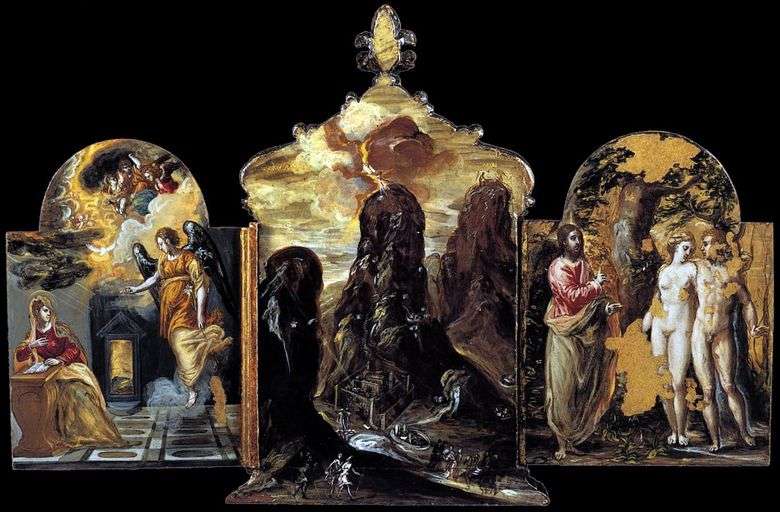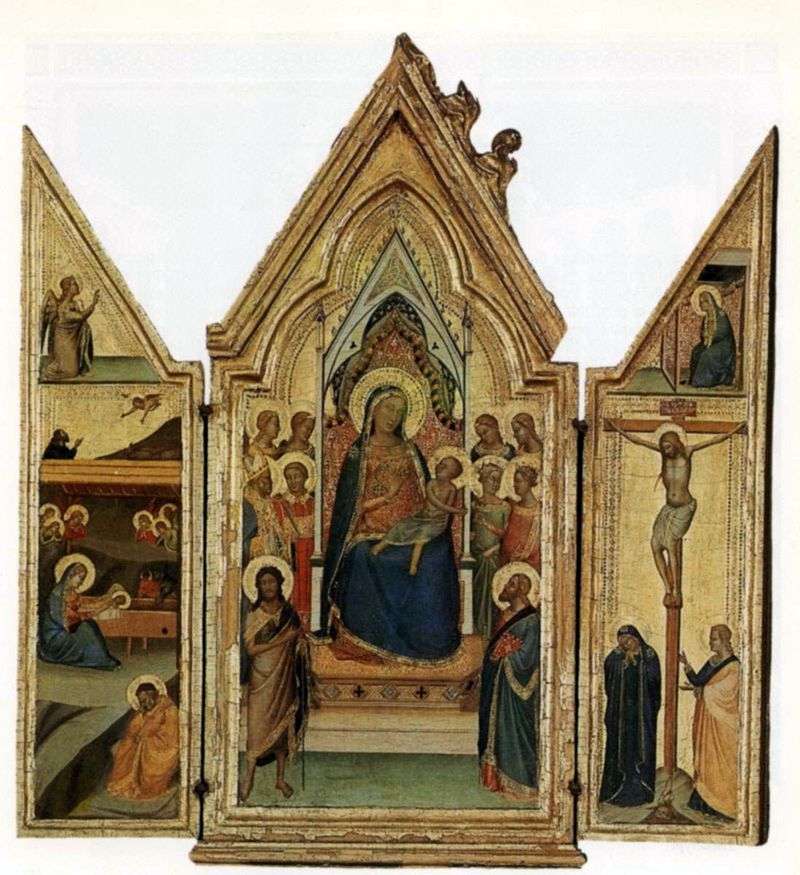
Domenico Theotokopuli, known to us under the name El Greco, wrote a triptych, which was called Moden in his place of storage, or “Annunciation on Mount Sinai.” A small composite altarpiece with hinged side panels, painted on both sides, is typical of Crete of the XVI century, but its frame is closer to the Italian Renaissance. Perhaps his client was a representative of the Cretan-Venetian family. The side flaps of the triptych are opened in turn; he conducts the spectator from the fall of man to justification through Christ.
On the front side there are scenes:
“Adoration of the Shepherds”, “Allegory of the Christian Warrior” and “The Baptism of Christ”;
On the other side:
“Annunciation”, “Mount Sinai” and “God the Father warns Adam and Eve.”
“Allegory of the Christian Warrior” is the central scene on the front side, it is difficult to perceive, full of biblical allegories and symbols. In the upper part of the central plank, in the skies the artist depicted how a kneeling Christian warrior receives a crown from Christ. In the lower part are depicted purgatory and hell, as well as three biblical virtues. This work is reminiscent of works popular in the Middle Ages, especially in the depiction of the jaws of hell – a purely medieval element. Below the figures of Christ and the warrior is St. Catherine, with a wheel symbolizing her martyrdom.
In the center of the reverse side of the triptych is the scene “Mount Sinai” with the monastery of St. Catherine, which owes its appearance to Crete, and exactly repeats the traditional Byzantine model. The reference to St. Catherine in both central plaques may suggest a connection between the artist and the Cretan monastery of St. Catherine, the leading art school of the island. The other scenes of the triptych are also not unique, however, as an example, the artist used Italian prints. In general, repeated repetition of canonical scenes is typical of Byzantine art.
Triptych draws attention to the fact that this is one of the early surviving works of El Greco, created soon after arriving in Italy. The artist got acquainted with the Italian painting school, and took the first steps in the new technique. The flatness, linearity, geometric plans of the Byzantine tradition are replaced by compositions with rounded, denser forms and a more free interpretation. In the triptych there is some tension, typical for the manner of El Greco, as well as many elements and compositions, to which he will later return. Some of the greatest paintings of El Greco are created on themes “Annunciation”, “Adoration of the Shepherds” and “Epiphany”. The allegory of the Christian warrior is reminiscent of the allegory of the Holy League.
 Mount Sinai by El Greco
Mount Sinai by El Greco Triptych of Marriage by Rogier van der Weyden
Triptych of Marriage by Rogier van der Weyden Monte Sinaí – El Greco
Monte Sinaí – El Greco The Position of Christ in the Coffin by El Greco
The Position of Christ in the Coffin by El Greco Tríptico de Módena – El Greco
Tríptico de Módena – El Greco Healing of Jericho Blindness (Triptych Side Sash) by Lucas-van Leiden
Healing of Jericho Blindness (Triptych Side Sash) by Lucas-van Leiden Triptych by Bernardo Daddy
Triptych by Bernardo Daddy Annunciation by El Greco
Annunciation by El Greco